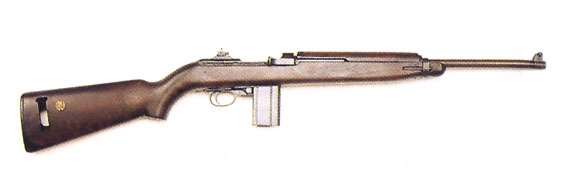 |
|
| Weapons
This is usually everyone's favorite part to read. It's where you get the real bang for your buck. So, let's get in to it.
In 1932, the US Army approved the production and issuance of a semi-automatic rifle to be distributed it's soldiers a main combat arm. The M1 Garand would be the first general-issue semi-automatic rifle in the world. By the end of 1936, American soldiers were having their WW1-issue 1903 bolt-action rifles replaced by the new M1.
|
 |
 The M1 Garand is a .30-06 caliber rifle that fires eight rounds which are loaded in at once from an en bloc clip. Unlike modern clip-fed weapons, the clip is not detachable and actually gets housed completely inside the magazine. Essentially, you need to fire all eight rounds before you can reload. At the last round, the en bloc clip will pop out, making that signature ping that lets those nearby know you were going to reload. The M1 Garand is a .30-06 caliber rifle that fires eight rounds which are loaded in at once from an en bloc clip. Unlike modern clip-fed weapons, the clip is not detachable and actually gets housed completely inside the magazine. Essentially, you need to fire all eight rounds before you can reload. At the last round, the en bloc clip will pop out, making that signature ping that lets those nearby know you were going to reload.
The M1 Garand rifle weighs roughly 10 pounds, a lot heavier than the 8.5 pounds of the Vietnam-era M-16 and today's 3 pound M-4 Carbine. In addition to the wieght, the rifle is long - measuring in at 43.5 inches. Skilled handlers use this weapon with ease, but it proved to be a bit cumbersome for those who needed to operate heavy weapons, vehicles, or other equipment. So, a few years after the M1 Garand, the M1 Carbine was designed in mind to soldiers who needed a lighter weapon for self-protection that wouldn't burden them from doing their main duties. By mid-1942, troops were receiving the lighter weapon.
|
 |
|
The M1 Carbine chambers a lighter .30 caliber round, not compatible with the M1 Garand. It has a detachable 15-round magazine that can be removed at any time the operator wishes. Folding-stock models (M1A1) were issued to paratroopers. We encourage that your first choice in finding a rifle would be the M1 Garand. However, given the nature of Armored Infantry, the Carbine is an acceptable alternate if the opportunity to buy one arises.
Another rifle that is acceptable, but not encouraged over an M1 Garand, is the 1903 Springfield. By 1938, the M1 Garand was integrating into the US Army. However, this weapon saw service in early conflicts in the hands of Marines and with Army units who opted for the weapon depending on the mission or had not yet received their M1 Garand issue. The sniper variant (pictured), is rare to find and only one was authorized per rifle platoon.
|

|
Each soldier was given a bayonet to attach to their rifle and for close self-defense. Originally, the Army was issuing long, 16" bayonets that were issued to their forefathers in WW1. The 1905 Bayonet was still in service right up in to the early phases of US involvement in WW2. These types of bayonets are very expensive as many were cut down during WW2 to 10 inches when the issuance of a new and shorter bayonet became the standard issue. They came in a fiberglass or a canvas scabbard.
|

|
The M1 Bayonet is 10" and is sheathed in a fiberglass scabbard. It has the same mechanism as the 1905, making it capable of locking on to an M1 Garand or a 1903 Springfield. Many M1s were cut-downs of the 1905 Bayonet. This is the type of bayonet you should acquire. |

|
Pistols
Before the M1 Carbine was issued, soldiers not serving on the line or who had their hands full with other duties while in combat, such as Engineers, Heavy Weapons troops, and drivers, were issued pistols and sub-machine guns. Also, officers and non-commissioned officers were given a side-arm. The standard side-arm of the US Army was the M1911A1 Colt .45 Semi Automatic Pistol.
|
 |
|
The M1911A1 pistol fires a .45 ACP round from a magazine that holds seven. A veteran of WW1 (then called just M1911), the pistol has strong knockdown power and good ruggedness. This weapon was exclusively issued, so it's not common for enlisted line soldiers to have them in their possession.
Another pistol that is found amongst the infantry was the M1917 Revolver. Again, not a common item as revolvers were not a common issue. Another model is the 38 cal. S&W Victory. Revolvers were usually "acquired" by soldiers, either through barter and trade or clever appropriation.
|
 |
Automatics
The US Army recognized the benefits of automatic firearms in WW1 for fire suppression and many of those weapons found their place in WW2. The M1919 Machine Gun and the M2 .50 cal Machine Gun were heavy weapons that were mainstays for the Army infantry platoons and vehicles. For the infantry platoon, it was the M1918 Browning Automatic Rifle, commonly known as the BAR.
|
 |
|
The BAR was used as the war's squad automatic weapon. It was heavy, weighing in at about 16 to 19 pounds, fired a 20-round detachable magazine of .30-06 cartridges that were compatible with the M1 Garand and the M1919.
|
|

